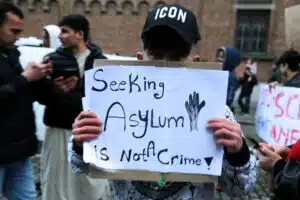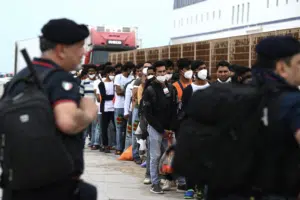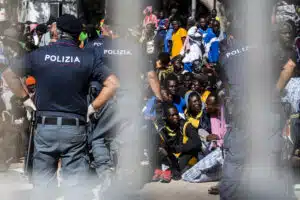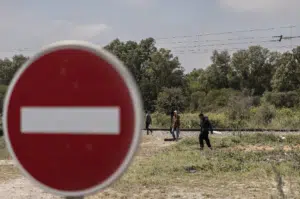Brussels – It could be said that it will be an obtorto collo vote. Still, the European Parliament’s responsibility for the final outcome of the Migration and Asylum Pact is rooted in the very choices over the past year by individual file negotiators to give in on almost all of the initial red lines to bring home an agreement with the 27 EU governments in the field of migration and asylum. The approach that “a poorly done deal is always better than no deal at all” allowed the EU Council to impose its negotiating line almost in its entirety and led MEPs today—on the eve of the final plenary vote—to stop rejoicing over a “historic agreement” and speak exclusively of “political responsibility” in approving the December 20, 2023, deal to have a harmonized framework at the European level after years of legislative process and in time for the June elections.
 Twenty-four hours before the plenary vote on the ten dossiers that now make up the Migration and Asylum Pact (and on this, too, it is worth mentioning how the Council has unilaterally decided to split two files and introduce amendments not agreed upon with negotiators from the EU Parliament, amid general silence from MEPs) it is quite clear from the comments of the eight negotiators at today’s (April 9) press conference that no one in the hemicycle is really satisfied with what’s on the table. “I can’t say I’m completely happy, but I can confirm that it’s an improvement over the current situation, and it would be bad news for the European cause not to get anything done after so much effort,” explained an unusually unbold Juan Fernando López Aguilar (S&D), rapporteur for the Crisis and Force Majeure Rules. “If you vote against it, what’s the pro in the status quo?” tried to be more assertive, the rapporteur on the Asylum and Migration Management Regulation, Tomas Tobé (EPP): “My job now is to convince my colleagues to stick to the promise of having a common framework.”
Twenty-four hours before the plenary vote on the ten dossiers that now make up the Migration and Asylum Pact (and on this, too, it is worth mentioning how the Council has unilaterally decided to split two files and introduce amendments not agreed upon with negotiators from the EU Parliament, amid general silence from MEPs) it is quite clear from the comments of the eight negotiators at today’s (April 9) press conference that no one in the hemicycle is really satisfied with what’s on the table. “I can’t say I’m completely happy, but I can confirm that it’s an improvement over the current situation, and it would be bad news for the European cause not to get anything done after so much effort,” explained an unusually unbold Juan Fernando López Aguilar (S&D), rapporteur for the Crisis and Force Majeure Rules. “If you vote against it, what’s the pro in the status quo?” tried to be more assertive, the rapporteur on the Asylum and Migration Management Regulation, Tomas Tobé (EPP): “My job now is to convince my colleagues to stick to the promise of having a common framework.”
On the eve of the vote in plenary, the far-right Identity and Democracy and the Left Group will certainly vote against it. More uncertain is the position of the Greens/Ale, while the majority EPP-S&D-Renew Europe and part of Ecr should on the whole hold, albeit with expected defections such as those of the Democratic Party (the head of the delegation, Brando Benifei, said in a note that “for us as Italians in the PD is really too little and that is why we will vote against“). However, attention will have to be paid to individual dossiers since “we have always advocated a package approach, and if one falls, the whole architecture falls,” warned the rapporteur on the amended Asylum Procedures Regulation, Fabienne Keller (Renew Europe). “We know that there will not be a new proposal on the table soon; I say this to those who will oppose it for reasons I can understand,” remarked her political group colleague and rapporteur for the Reception Conditions Directive, Sophie in ‘t Veld, without hiding the fact that “we could have done much better in the last five years.” More critical was the rapporteur for the Screening Regulation, Birgit Sippel (S&D)—”with the concept of “safe third country” we don’t really want a reception system for anyone who needs it”—although she later realigned herself with a sense of responsibility: “We were not satisfied even with the commission’s proposal, but there are positive points, and we have the opportunity to have common rules.” 
The fact remains that, at least on paper (because implementation is another matter), managing migration and asylum under the new Pact will overwhelmingly result from agreements among the 27 EU governments. It’s the failure of the European Parliament on almost every line, even though the starting point was not even that ambitious. In the Regulation for the Management of Asylum and Migration (RAMM), relocations of migrant persons between member states are no longer a “primary measure of solidarity” as demanded by MEPs but are on par with financial contributions or support to third countries. In the Asylum Procedures Regulation (APR), national and EU lists of “safe third countries” and de facto detention for up to six months with no exemptions even for families with children under 12 were imposed by the council. The so-called “fiction of non-entry” has entered the Screening Regulation without exception, and the monitoring mechanism does not apply to border surveillance activities. The Eurodac Regulation shows inconsistency with the standards applied to EU citizens according to the GDPR on biometric data collection. National authorities can indiscriminately collect photographic data of faces, not to mention the Crisis and Force Majeure Regulation, which has seen enforced integration of Instrumentality Regulation and no move to a mandatory relocation mechanism between member states in a crisis.
The basis of the Migration and Asylum Pact
The basis on which the new Migration and Asylum Pact system is set is the relationship between solidarity and responsibility in managing migrants among the twenty-seven countries. The former concept permeates the Regulation for the Management of Asylum and Migration (RAMM), which in no way overrides the cardinal principle of the 2013 Dublin Regulation, namely that the task of examining the asylum claim of a person who enters the EU territory irregularly lies with the first EU member state to which they enter. Countries such as Italy, Greece, Malta, Cyprus, and Spain will be responsible for applications, while other member states that want to “dublin” (i.e., extradite) these migrants (including minors and those applying for reunification with siblings) will simply have to send a notification, no longer a reciprocal due process request with the agreement of the country of first arrival as is the case today. After the Regulation enters into force— 24 months after its publication in the EU Official Journal—the now famous mandatory solidarity mechanism for all twenty-seven countries (based on GDP and population) will be introduced, which equalizes three forms of solidarity: relocations of migrants, financial contributions, or support to third countries. Contributions to member countries can be directed not only to reception systems but also to funding fixed and mobile border facilities through the Border and Visa Management Instrument (BMVI) and the Asylum, Migration and Integration Fund (AMIF). There is no mandatory relocation for migrants disembarked after search and rescue operations at sea, and for those under the RAMM procedure, there is no legal representation, only counselling.

The concept of accountability is particularly related to the Asylum Procedures Regulation (APR), which increases only those provided for countries of first entry. It will automatically apply if there is a risk for security threat issues (including unaccompanied minors), of “deception of authorities”, or if the migrant person comes from a country with a recognition rate of less than 20 per cent. Border procedures will provide de facto detention, with no exemptions even for families with children under 12, nor legal representation, nor a stay for appeals against most decisions (the exception is for inadmissibility of those based on the concept of “safe third country” and for unaccompanied minors). Crucial to this Regulation is precisely the “Safe Third Country” concept, for which both an EU list and national lists are provided to justify and expedite rapid returns out of the Union unless the individual person links to the state in question preclude their safety. New accountability obligations include completing the examination of an asylum application through the border procedure within six months (APR) but also extending the responsibility for handling applications for 20 months and maintaining 12 months for search and rescue operations at sea (RAMM). The annual ceiling for border procedures, determined on the basis of a formula that takes into account the number of irregular border crossings and the number of expulsions in the previous three years, is set at 30,000 people.
What happens when migrant people arrive
Once migrants arrive at the Union’s borders, the Regulation on Screening of the Migration and Asylum Pact will provide a 7-day detention procedure for the division between regular (RAMM) or expedited (APR) procedures for processing asylum claims. Since the so-called “fiction of non-entry” has remained (that is, that anyone who is screened in a special centre will not be considered legally on the territory of the member state and therefore of the EU), in fact migrants will be detained, as they will have to remain at the disposal of the authorities without the possibility of entering the national territory. Some guarantees include the possibility for applicants to have access to a copy of the screening form and the preservation of the “relevant rules on detention” set out in the 2008 Return Directive (the revision contained in the Migration and Asylum Pact is the only dossier that is certain to fail). However, the monitoring mechanism (which does not necessarily include NGOs but can do so at the discretion of states) does not apply to border surveillance activities (with normalization of racial profiling), and, if the state recognizes a security threat, it will be able to grant national authorities direct access to all data on the person in all databases.

With regard to databases, according to the Eurodac Regulation, all migrant persons benefiting from temporary protection from the age of six years will have to accept the collection of their biometric data, even though under the General Data Protection Regulation (GDPR), processing is lawful only if the minor is at least 16 years old. Included in the expansion of data access for national authorities is the collection of photographic data of faces, effectively giving a green light to the mass surveillance of people arriving in EU territory. Security alerts to be entered into the Eurodac database during the screening process and border procedures will include a whole range of new categories (such as irregular border crossing) also through the revision of the Entry and Exit System Review Regulation.
What happens in a crisis
One of the most controversial items in the Migration and Asylum Pact is the Regulation for Crises, Instrumentality and Force Majeure, which deals with times when there is an exceptional or unexpected “mass arrival of people,” including following disembarkation after a search and rescue operation at sea. In fact, the Council negotiating position passed, which led to the inclusion of instrumentality (a Regulation that was initially a stand-alone and on which Parliament had not given the OK) in that for crises and force majeure, in cases where “a hostile third country or non-state actor encourages or facilitates the movement of third-country nationals and stateless persons” towards the EU external borders “intending to destabilize the Union or a Member State” by putting “the essential functions of a Member State at risk.” NGOs are excluded from this definition, but in fact, only if they can demonstrate that their actions (at sea and otherwise) are not intended to destabilize, with clear risks of repercussions for the criminalization of solidarity.

No compulsory relocations of migrants between member countries are envisaged in crises either. Still, the same three modes of solidarity as in the RAMM Regulation (relocations, financial contributions or support to third countries) will apply. Instead, derogations to the overall migration and asylum management system are triggered in this scenario: the recognition rate threshold for which people can be admitted to border procedures (under the APR Regulation at 20 per cent) is raised to 50 per cent in force majeure situations, 60/70 per cent in crises, and 100 per cent in instrumentality situations. Again, from the border procedures—whose duration can be extended by an additional six weeks (compared to the nine months in Apr)—families with children under 12 are not excluded.








